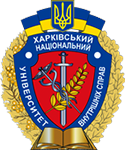Transformations in the police organization in the early 1920s
Abstract
The main aspects of changes in the organization of the police in the early 1920s have been revealed. At that time there was a complex, controversial, but quite consistent formation process of the police in Ukraine as a law enforcement agency. Significant changes in the organization of the police have been noted. The functions of the police and criminal investigation were separated, which, as time proved, was a mistake. In 1923, there were changes in the structure of the police, closely related to the administrative reform in the republic. County and parish police departments were replaced by circute and district police departments. The expansion of circutes and districts had led to a corresponding expansion and strengthening of local police departments, which was positive. The number of police in 1921–1923 decreased by 20 times, which had led to negative consequences. The qualification of many police officers was low, they lacked basic literacy. In the early 1920s, the issue of further development and structure of the police, centralization and decentralization of its bodies was not sufficiently resolved. The issue of the relationship between the police and other public and private bodies was also not settled. Training in the police was not organized, the use of technical means in its activities lagged behind. However, in 1923 a number of important legal acts regulating the organization and activities of the police were adopted. These are, first of all, the Rules of Service and the Police Disciplinary Statute. In the first of the named documents, it was stated that persons who joined the police and investigation service are considered civil servants. This was of significant importance for raising the social status of police officers. According to their official status and type of activity, police and detective workers were divided into the following categories: a) regular staff, which was subdivided into command staff of the police, detectives and police officers; b) political staff; c) administrative staff; d) clerical staff; and e) non-staff personnel. The Police Disciplinary Statute was a new type of departmental legal act. It was the first to define the concept of police discipline. Incentive for integrity and strict liability for violation of official duties by police officers were foreseen. Serious violations, which were qualified as criminal offences, entailed judicial responsibility for the police officer.
Downloads
References
Bandurka O.M., Grechenko V.A. and Yarmysh O.N., 2015. Formation and development of the militia of Ukraine (1921–1930) [Stanovlennia ta rozvytok militsii Ukrainy (1921–1930 rr.)]. Kharkiv: Zolota mylia.
Sokurenko V.V., Bandurka O.M. and Grechenko V.A., 2017. Training of law enforcement officers in Kharkiv: 100 years of history (1917–2017): to the 100th anniversary of the events of the Ukrainian Revolution [Pidhotovka okhorontsiv pravoporiadku v Kharkovi: 100 rokiv istorii (1917–2017 rr.): do 100-richchia podii Ukrainskoi revoliutsii]. Kharkiv: Zolota mylia.
Silvestrov M., 1923. Criminal crime and search. [Kryminalna zlochynnist i rozshuk]. Shchyt revoliutsiinoho poriadku, No. 1, p. 16.
1923. Review of militia activities for the first third of 1923 [Ohliad diialnosti militsii za pershu tretynu 1923 r.]. Shchyt revoliutsiinoho poriadku, No. 1, p. 60.
Oko, 1923. The wills of the school are fulfilled [Zapovity shkoly vykonuiut]. Shchyt revoliutsiinoho poriadku, No. 1, p. 58.
Oleinyk V., 1925. To the sixth anniversary of the militia of the Kharkiv Region [Do shostoi richnytsi militsii Kharkivshchyny]. Biuleten NKVS, No. 2, p. 47.
I. H. M., 1923. Militia sores [Militseiski boliachky]. Shchyt revoliutsiinoho poriadku, No. 1, p. 9.
Makarenko I., 1923. Main work [Osnovna robota]. Shchyt revoliutsiinoho poriadku, No. 1, p. 12.
Fedotov K., 1923. Next tasks of the militia [Cherhovi zavdannia militsii]. Shchyt revoliutsiinoho poriadku, No. 1, p. 4.
Nik. Ov., 1923. Police service as a profession [Sluzhba v militsii yak profesiia]. Shchyt revoliutsiinoho poriadku, No. 1, p. 8-9.
1923. Regarding the issue of streamlining the postal service [Do pytannia pro vporiadkuvannia postovoi sluzhby]. Shchyt revoliutsiinoho poriadku, No. 1, p. 14.
Zaitsev B. and Myhal B., 2008. Kharkiv City Militia in the 1920s. [Kharkivska miska militsiia v 1920-kh]. Universitates, No. 4, p. 33.
Chornukha O.V., 2012. Formation and activity of internal affairs bodies of the Kharkiv region during the years of the NEP (1921–1929) [Formuvannia ta diialnist orhaniv vnutrishnikh sprav Kharkivshchyny v roky nepu (1921–1929)]. Ph.D. dissertation. V. N. Karazin Kharkiv National University.
Shapoval Yu. (Ed.), 1990. Routes of history [Marshrutamy istorii]. Kyiv: Politvydav Ukrainy.
1923. On credit… [V kredyt…]. Shchyt revoliutsiinoho poriadku, No. 2, p. 12.
1923. Ripe questions [Nazrili pytannia]. Shchyt revoliutsiinoho poriadku, No. 1, p. 7.
Yelysieiev, 1923. About awarding criminal investigation workers [Pro premiiuvannia pratsivnykiv kryminalnoho rozshuku]. Shchyt revoliutsiinoho poriadku, No. 2, p. 15.
I. M., 1923. Police station [Militseiskyi post]. Shchyt revoliutsiinoho poriadku, No. 1, p. 6.
Rakytov H., 1923. Militia in the village [Militsiia na seli]. Shchyt revoliutsiinoho poriadku, No. 1, p. 5.
Copyright (c) 2022 V. A. Grechenko

This work is licensed under a Creative Commons Attribution 4.0 International License.



